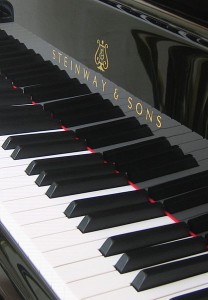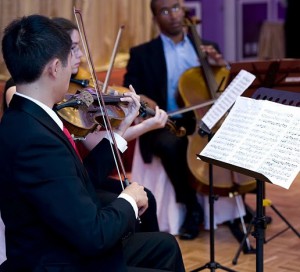Music and Medicine
 by Danielle Ofri
by Danielle Ofri
The Lancet
The moment has finally arrived. After 3 years of sweating through etudes, scales, and Suzuki practice books, my teacher utters the words that every cello student yearns to hear: “It’s time to start the first Bach suite.”
It started on a lark, really, when I asked my daughter’s first violin teacher how to coax a child to practice. She casually commented that the best thing is to see a parent practice. I hailed the nearest taxi and promptly purchased a cello. I started lessons, applying the same brute-force approach I’d acquired in medical school, playing the assigned notes over and over again until they were seared in my memory like the Krebs’ cycle and the 12 cranial nerves.
I added cello to the chores of my life–caring for patients, teaching, writing, and editing. But over the 3 years, an unexpected transformation occurred. Far from being a chore or a parental device to influence my daughter’s propensity to practice, cello turned out to be something that I genuinely wanted to do each night, almost to the exclusion of all else. Newspaper reading shrunk to cursory glances. Phone calls were avoided. Medical journals slipped to the subterranean level of the reading pile. Journal subscriptions lapsed.
I still love my day job, taking pleasure in teaching students and connecting with patients, but I have to be honest that, at this point in my career, the sense of growth has remained at a relatively steady state. With music, however, the intellectual challenges develop in ways that are new and surprising to me. The trajectory of learning, of frustration, and of accomplishment for the beginning musician has more in common with the intellectual vibrancy of life as a beginning medical student. I find that I am more driven to enhance my musical skills than I am my medical skills, although I certainly don’t wish the latter to falter.
 As I continued to pursue the cello in the evenings, hospital-corridor conversations during the day revealed musicians hidden in all sorts of unlikely clinical corners: the pathologist who played violin, the ER doctor who was an accomplished cellist, the clinic director who played saxophone, the student who’d flipped a coin between Julliard and medical school, the anesthesiologist who studied flute at Eastman School of Music before “retiring” to a more practical career, the pulmonary fellow whose legendary beer-chugging habits masked a prodigious violin repertoire. Was this just a matter of uncovering a common hobby by making the effort to look, or might there be some intrinsic connection between?
As I continued to pursue the cello in the evenings, hospital-corridor conversations during the day revealed musicians hidden in all sorts of unlikely clinical corners: the pathologist who played violin, the ER doctor who was an accomplished cellist, the clinic director who played saxophone, the student who’d flipped a coin between Julliard and medical school, the anesthesiologist who studied flute at Eastman School of Music before “retiring” to a more practical career, the pulmonary fellow whose legendary beer-chugging habits masked a prodigious violin repertoire. Was this just a matter of uncovering a common hobby by making the effort to look, or might there be some intrinsic connection between?
I knew there was a doctors’ orchestra here in New York City, and as I started poking around I learned that there were others in Boston, Houston, Los Angeles, and Philadelphia. There was also one in Europe, one in Jerusalem, one in Australia; even a World Doctors’ Orchestra.
Was this merely because most doctors grew up in middle-class homes conducive to music lessons? I searched other professions, and uncovered one lawyers’ orchestra in Atlanta. But I couldn’t find a single accountants’ orchestra, or architects’ orchestra, or engineers’ orchestra. There wasn’t any orchestra made up of Wall Street executives, computer programmers, government officials, or direct marketers.
There have been writings about the relation between medicine and the listening aspects of music, but nothing on the playing of music. Why do so many doctors pursue music? Why does the orchestra of doctors in Boston (the Longwood Symphony) receive audition inquiries on a daily basis?
Mark Jude Tramo, a neurologist, songwriter/musician, and director of The Institute for Music and Brain Science at Harvard and Massachusetts General Hospital, feels that “there is overlap between the emotional and social aspects of relating to sick patients and communicating emotion to others through music. Some would speculate that there is [also] an overlap between aptitude for science, which most premeds major in, and for music.”
 Lisa Wong–violinist, pediatrician, and president of the Longwood Symphony Orchestra–speaks for the many who came to medicine after years dedicated to serious musicanship. “The music we create builds in us an emotional strength, sense of identity, and sense of order. Then it is given away–we play for others, we play in ensembles. We come to medicine and it is the same thing. The giving, the service–in music and medicine–is a natural connection.”
Lisa Wong–violinist, pediatrician, and president of the Longwood Symphony Orchestra–speaks for the many who came to medicine after years dedicated to serious musicanship. “The music we create builds in us an emotional strength, sense of identity, and sense of order. Then it is given away–we play for others, we play in ensembles. We come to medicine and it is the same thing. The giving, the service–in music and medicine–is a natural connection.”
Michael Lasserson, a British double-bass player, retired family physician, and founder of the European Doctors’ Orchestra, speaks from the perspective of the dedicated amateur. Although he was raised in a family of professional musicians, it was clear rather early on that he was headed for medicine rather than the stage. But, “music never lets you go,” he says. And it is more than just a hobby to make one a happier doctor. “It is a means whereby one is lifted away from the essential loneliness of clinical decision-making and action, into a world of a common enthusiasm and endeavor as the group searches for the beauty of sound [and] the composer’s intent, and those few hours have what can only be described as a healing function.”
There is also the risk-taking that offers parallels between medicine and music. It takes a certain amount of fortitude to slice open a patient’s abdomen with a scalpel. No less is required to take on Mahler’s seventh or the late Beethoven string quartets. “We hurl ourselves with suicidal courage against the commanding heights of the repertoire,” Lasserson says, hoping just to “touch the hem of that greatness,: though he acknowledges that sometimes, for the amateur, “miming skills will come to the fore.”
I debate this every night as I approach that single precious hour of energy after all the childcare has been completed and before exhaustion forces me to bed. Do I read that groundbreaking clinical trial that will surely impact my practice? Do I work on that unfinished book chapter? Do I read the newspaper and catch up on world events? Do I organize the entropy of my desk? Do I exercise for 30 minutes as I routinely exhort my patients to do?

Unfailingly, the answer is “none of above.” No matter how tired I am, no matter how much neuronal lint has accumulated throughout the day, I tighten the hairs on my bow and dig the end-pin of the cello into my rutted carpet. As I start to work on my assigned music for the week, I find myself focusing ever more narrowly on a single page, a single line, a single measure–even a single note.
Temperamentally, this is the exact opposite of life in the hospital, in which I feel pelted by ringing phones, needy patients, impossible schedules, irritating bureaucracies, and a cacophony of meaningless minutiae. It is a glorious relief, instead, to struggle for–and occasionally achieve–precisely the right note. But then, there is a step even beyond that. The note doesn’t have to merely be right–it also has to be beautiful.
Beauty is not something that gets much shrift in medicine. Other than the experimental design of a classic study that might be referred to as “elegant,” there isn’t much in medicine that falls into the category of beauty. Beauty is inherently unpragmatic–it doesn’t enhance efficiency, increase productivity, earn a grant, or cure a patient. Maybe it is this lack of beauty that drives doctor-musicians to struggle to draw some into their lives via music.
But perhaps there is indeed something in medicine that is related to beauty. After all, medicine is about life–the wriggling, sensual, bodily aspects of being alive. This is not something that can be said about engineering, law, or accounting. Although being alive–and being sick–can frequently be unpleasant, it never ceases to be miraculous. That miraculousness–and the privilege of doctors to be part of it–is a beauty in itself.
Willa Cather once said, “Novelists, opera singers, even doctors, have in common the unique and marvelous experience of entering into the very skin of another human being.” The beauty of entering the very skin of another human being is how many musicians describe the emotional experience of playing music. And for many, it is the striving to achieve that–almost more than the attainment–that offers the most pleasure. As we physicians strive to achieve the best for our patients in the messy, corporeal world of clinical medicine, we work to enter that very skin of another human being, and perhaps–with luck–we can touch the hem of that greatness.
Touching the hem is about all I can aspire to, but that’s enough. I’m willing to grovel for that. The sheet music of the first Bach suite appears straightforward–two pages of evenly spaced notes in the agreeable key of G. No intricate timing, no double-sharps, no key shifts, no clef shifts, no fancy ornamentation. But as anyone who as ever tussled with Bach knows, that simplicity is ruthlessly deceptive. “One measure at a time,” my teacher has instructed me. “It needs to be completely memorized. Expect to put in about a year on this.” This is said without irony.
Week after week, month after month, I tiptoe gingerly through the music. The melodic phrases are simultaneously simple and horrifically complex. But when I’ve survived a measure and can play several notes in sequence, the beauty is astounding–the type of beauty that really does take the breath away. I haven’t made it to the hem yet, and may never. But that’s okay. It’s all in the reaching.


